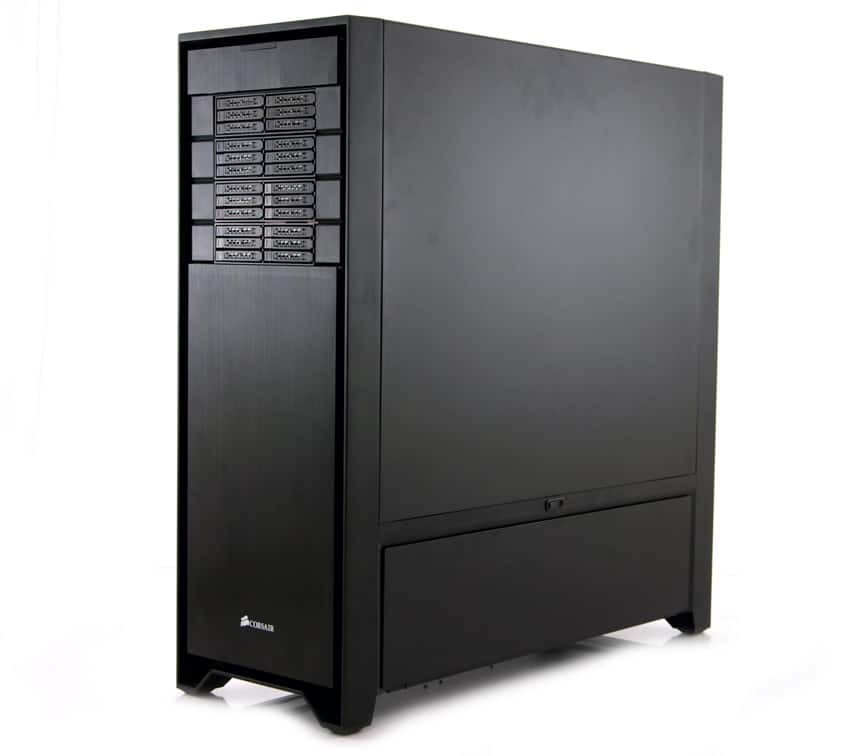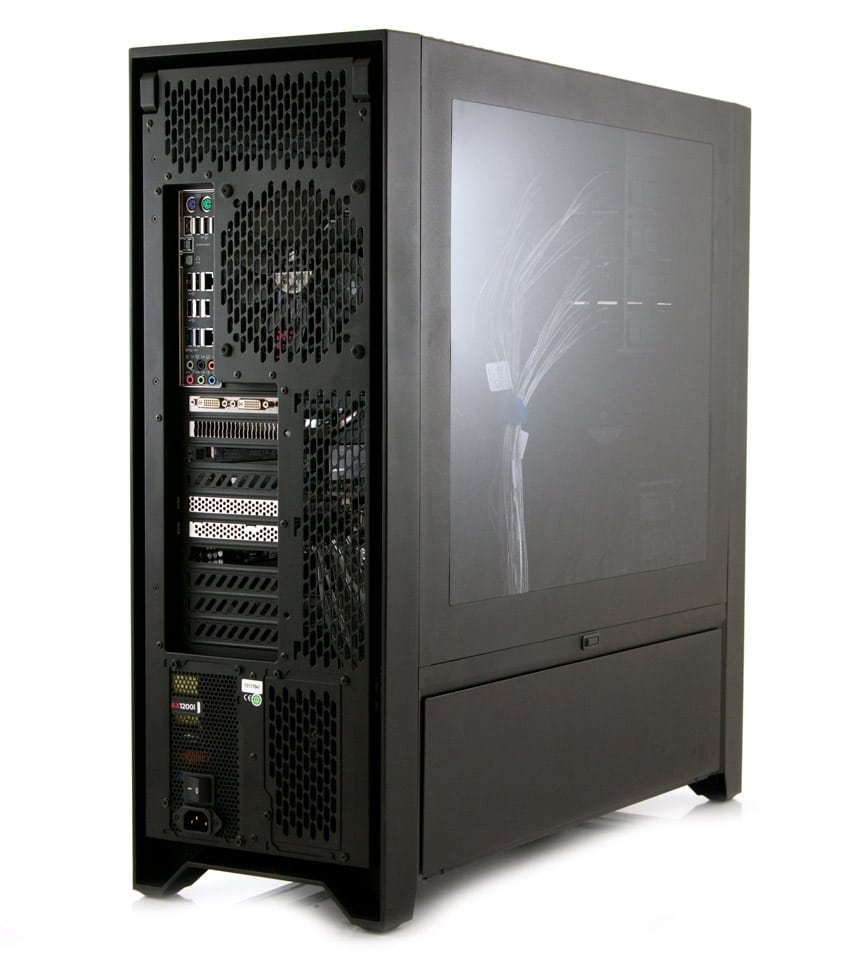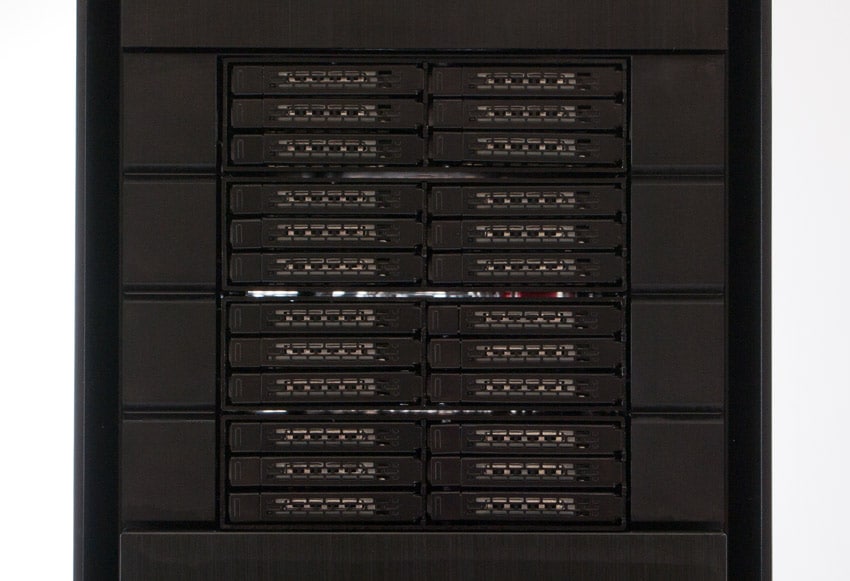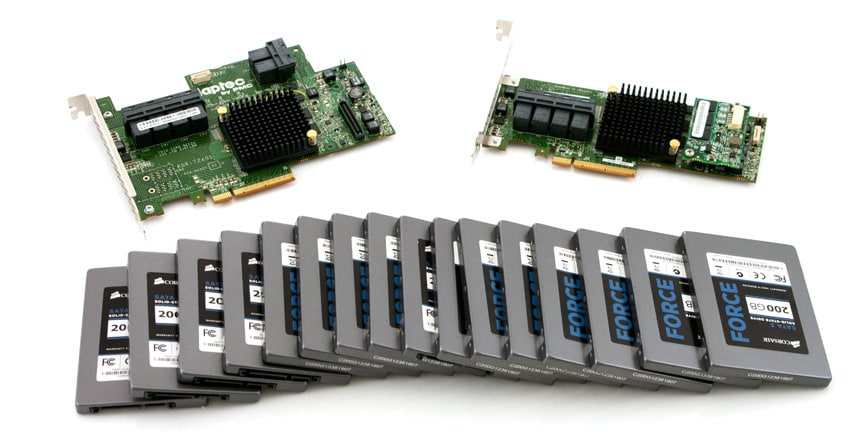
Corsair’s Obsidian Series 900D Super Tower is the manufacturer’s most robust, high-end case with ten expansion slots, up to fifteen internal 3.5″ drive bays, support for dual bottom-mounted power-supplies, and loads of other features for a wide-range of applications. The 900D has vaulted to the top spot as Corsair’s most premium case, adding to the well-established Corsair Obsidian Series 800D. This rig is for serious builders with big projects; whether users want to build an ultimate dream PC, add state-of-the-art liquid cooling, create a monster file server, or design a workstation capable of the most challenging design tasks, the 900D provides plenty of configurable space.
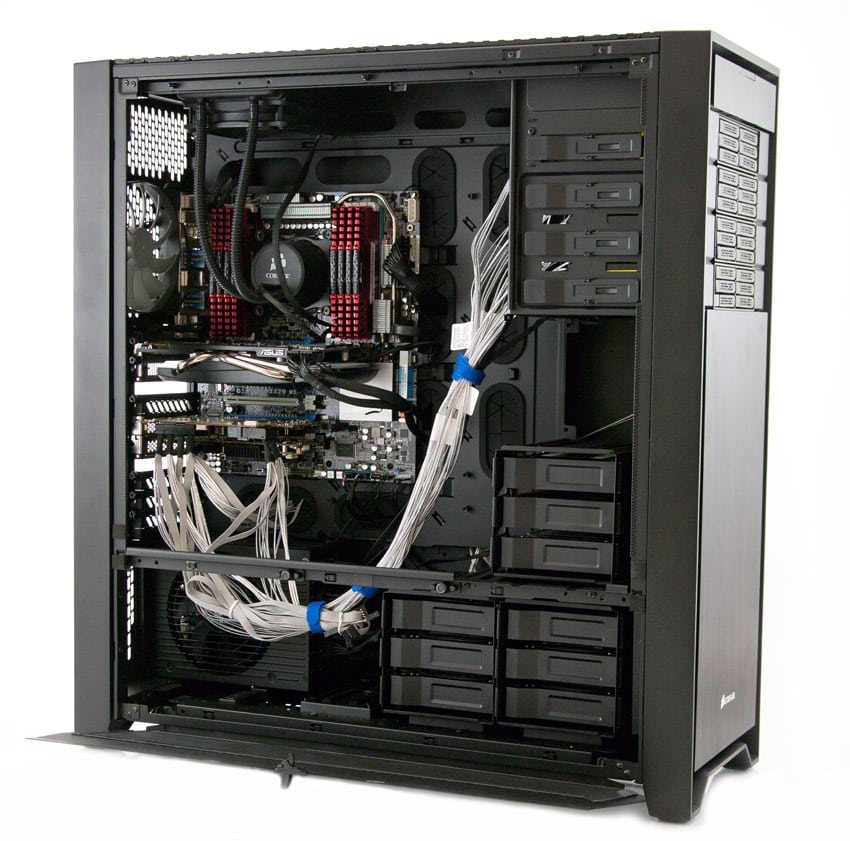
The 900D’s arrival to our office brings us the opportunity to create a system with tremendous capabilities in both storage capacity and performance. Though the external footprint is just a little bit bigger than the 800D, the internal space has been further optimized to yield far more headroom for all of our hardware. We got to work utilizing the extensive resources of our Enterprise Test Lab, and in doing so we brought together an impressive list of hardware from vendors including Corsair, Intel, ASUS, HGST, Adaptec, and Icy Dock. During the build, we created an even more robust storage powerhouse than we had previously established without Corsair 800D.
We’re confident that with all of the included hardware, the Corsair 900D can tackle most any application thrown at the intense workload ready case. Moving forward, we will be testing a wide range of devices using the 900D and our other equipment in the lab. Specifically, the 900D’s potency will enable us to gauge the advantages and limitations of hardware that comes through the labs designed for the enthusiast or creative professional space. Furthermore, with the plethora of PCIe slots, drive bays, and the sheer amount of space the 900D affords us for continued expansion, we will be able to see how it holds up as we run consistent heavy workloads within the machine.
The Corsair Obsidian Series 900D is currently available in limited quantities and comes with a 2 year warranty and a street price near $350.00.
Corsair Obsidian Series 900D Super Tower Case Specifications
- Form Factor – Full Tower
- Motherboard Support – ATX, EATX, HPTX, Micro ATX, Mini ITX
- Drive Bays
- (x9) 3.5″ Internal
- (x3) Hot-Swap Bays
- Upgradable to fifteen total (requires purchasing two additional cages)
- (x4) 5.25″ External
- (x9) 3.5″ Internal
- Cooling
- (x3) 120mm AF120L Front Fans
- (x1) 140mm AF140L Rear Exhaust Fan
- Up to fifteen total fan mount locations
- Five radiator mounting points:
- Front: up to 360mm
- Top: up to 480mm (4 x 120) or 420mm (3 x 140)
- Bottom side one: up to 480mm (4 x 120) or 420mm (3 x 140)
- Bottom side two (with PSU installed): up to 280mm (2 x 140) or 240mm (2 x 120)
- Rear: 140mm or 120mm
- Expansion Slots – 10 Slots
- Front I/O Panel
- (x4) USB 2.0
- (x2) USB 3.0
- Audio Front Ports
- Color – Black
- Material – Brushed aluminum front fascia with full cast aluminum surround structure front and rear
- Power Supply Mounted – Capable of two bottom mounted power supplies
- Side Window
- Dimensions (LxWxH) – 25.6″ x 9.9” x 27.2”
- Weight – 41 lbs.
- Warranty – 2 Years
Design and Build
The Corsair 900D came boxed in Corsair’s traditional fashion inside a general corrugated box with case graphics and information printed on it. The case itself came in a clear plastic bag surrounded with Styrofoam protection. Once you remove the black, full-cast aluminum case from the packaging, the 900D’s massive size is revealed. Compared to the Corsair 800D, this case stands a little over 3 inches taller and almost an inch wider.
Starting from the outside of the case, the exterior is heavily ventilated and is constructed of solid black aluminum all the way around to keep hardware cool. A build note that we quickly noticed is that the metal does feel like it has a little more give than on the 800D, though it feels sturdy enough. The front of the case houses the front I/O panel which consists of two USB 3.0 and four USB 2.0 ports, as well as a connection for audio. This is all nicely hidden behind a push panel. However, the power button is right near that panel and could easily be confused with a button to open the panel. Moving down a bit, there are four 5.25″ external drive bays, which we utilized fully to install 24 SSDs with our four Icy Dock ToughArmor MB996SP-6SB 6-in-1 Adaptors. Below these, there is a removable panel that shows the grille that vents the 120mm fans.
Switching around to the rear of the case, we get a view of all of the connectivity provided by our ASUS motherboard and the case’s 10 PCIe slots. To remove the brackets in the PCIe slots, there are screws users can twist out with fingers. However, some of them are too tight, and while the 800D had enough clearance to remove screws with a screwdriver, the 900D makes it pretty tough. Another design improvement we hope to see in the future is a bracket to mount a fan so that installed PCIe cards won’t overheat due to hotspots. This is important for many storage devices such as RAID cards and PCIe Application Accelerators. Rounding out the back of the 900D are an air intake ventilation with a 140mm fan mounted underneath it and space where users can mount up to two power supplies.
On the subject of the power supplies, inside the case there are no extensions for power supply cables (except for the 8-pin motherboard power cord), which makes cable management a bit difficult. Specifically, routing power from our Corsair AX1200i power supply to the 5.25″ bays or to certain 3.5″ bays inside the system left cords dangling diagonally across the inside of the case. In smaller cases on the market, cables can be neatly routed off to the side creating a clean, easier to manage layout. Corsair doesn’t offer extension cables, so that isn’t a possibility here unless you search for third party manufacturers.
The Corsair 900D offers users’ greater internal space and capacity in a fairly sturdy heat-reducing case. The 900D improves on the internal configurable space by including 6 standard 3.5″ bays and 3 hot-swap 3.5″ bays (versus a respective 3 and 4 on the 800D). Additionally, up to 15 drives can be installed with optional cages. On the other hand, 5.25″ bays have been reduced from 5 on the 800D to 4 on the 900D. This is part of what yielded more space for the 3.5″ bays, but some users might prefer an extra 5.25″ bay.
Performance
StorageReview Corsair Obsidian Series 900D Super Tower System Specifications
- Windows 7 Professional SP1 64-Bit
- Intel Core i7 3960X
- Corsair Hydro Series H50 CPU Cooler
- 64GB Corsair Vengeance (8 x 8GB)
- ASUS P9X79 WS motherboard
- ASUS GTX560 Ti graphics
- Corsair Professional Series Gold AX1200i Power Supply
- Corsair Obsidian Series 900D Super Tower Case
- Storage:
- Corsair Force GT SSD as Boot Drive
- Scratch Space (Adaptec 72405)
- 24 – Custom Corsair Neutron GTX 200GB SATA 6.0Gb/s SSD in RAID 10
- Accelerated Bulk Storage (Adaptec 71605Q)
- 6 – HITACHI Ultrastar A7K4000 4TB 7200 RPM 64MB cache SATA 6.0Gb/s hard drives in RAID 10
- 2 – Custom Corsair Neutron GTX 200GB SATA 6.0Gb/s SSD in RAID1EE for Cache
- One – Icy Dock EZ-Fit Pro Dual 2.5 to 3.5 Bracket (MB082SP)
- Four – Icy Dock ToughArmor MB996SP-6SB 6-in-1 Adaptor
We built our tower utilizing components from our high-end consumer testing platform with additional Adaptec RAID cards from our Enterprise Test Lab, as well as custom 200GB Corsair Neutron GTX SSDs and 4TB HGST Ultrastar 7K4000 hard drives. Gearing our storage space for performance and data integrity, we used a RAID10 configuration for both our SSD scratch space as well as our maxCache 3.0 accelerated bulk storage. With 24 200GB Corsair Neutron GTX SSDs configured in RAID10, we had 2.2TB of usable space that offered a tremendous amount of bandwidth. For traditional storage needs, we also had 6 of the 4TB 7K4000 configured in RAID10 giving us a bit over 11TB of capacity with maxCache 3.0 powered by two more 200GB SSDs in RAID1.
In terms of performance, sequential transfer speeds to our massive SSD array measured in excess of 6.5GB/s read and 3.0GB/s write. Switching to peak 4k random transfers, we saw 239,000 IOPS 4k write – or about 932MB/s in pure random write access. Random 4k read speeds were slightly quicker at about 267,000 IOPS. For professionals working in the content creation space, few storage options come close to offering that level of bandwidth in a local system.
The more modest 11TB of bulk storage still offered plenty of kick with sequential transfer speeds measuring 858MB/s read and 458MB/s write. Utilizing Adaptec’s maxCache 3.0 we saw dramatic read and write acceleration using two Corsair SSDs as cache. Random 4k transfers measured 70,200 IOPS read and 20,500 IOPS write.
Conclusion
Corsair’s Obsidian Series 900D Super Tower is a high-end case that can be configured to tackle just about any application. Corsair designed it to be used for a variety of cases such as building a high-end workstation capable of the most intense video editing, creating a huge file server, or for prosumers who want to build their perfect gaming PC. The case provides a ton of space to install hardware; there are ten PCIe slots and space for up to 15 internal 3.5″ drive bays and 4 5.25″ drive bays. Corsair also included case-wide ventilation, support for dual bottom-mounted power-supplies, four fans and lots of breathing room to keep the case cool.
When all is said and done the 900D Super Tower has several enhancements that help it claim the top spot in the Corsair product lineup, although we see it as more of a complement to the 800D than an outright replacement. It is physically larger and though bulky, provides users even more space for their hardware. The 900D has far more storage capabilities with up to 15 3.5″ drive bays using optional cages versus 7 bays in the 800D. It also better supports water cooling systems, with more space for water reservoirs as well as plenty of mounting points for large cooling radiators. At the end of the day, not all buyers need this much case for their compute platform, but should they it’s great that Corsair gives buyers that option.
Pros
- Supports up to 15 internal 3.5″ drive bays
- Very good build quality
- Lots of internal space for nearly any accessory
Cons
- No power supply extensions for 5.25″ drive bays
- No cooling fan for PCIe slots
Bottom Line
The Corsair 900D is an excellent rig for users who require tons of space to pack as much into their gaming system or workstation as possible.

